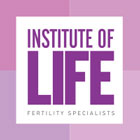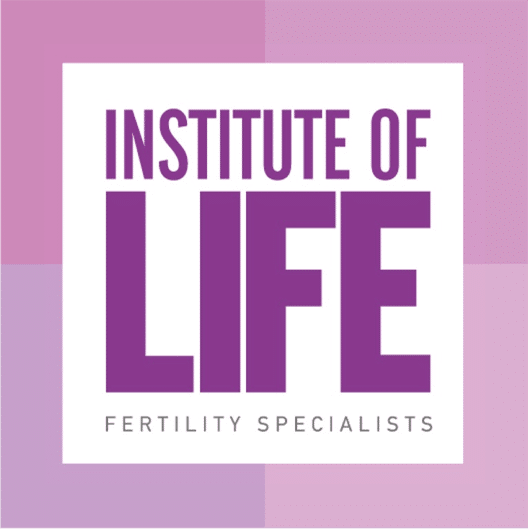Frequently asked questions (FAQ)

Get answers to your most frequent questions.
Primordial germ cells continue to be divided and by the fifth month of intrauterine life, a female fetus has 7 million eggs (oocytes) in its ovaries. Out of these eggs, half will die before the fetus is born and only 200,000-500,000 eggs will survive until puberty. During her reproductive life, a woman will need 400-500 eggs.
The time the eggs remain in the ovary is very important. The primordial germ cells are the precursors of the eggs and are very sensitive to the effects of environmental factors, such as radiation and medications. The eggs that women release in their later ovulations have stayed in the ovary for over 40 years and may possibly have undergone the adverse effects of the environment all this time. This is the reason we believe that an older woman runs a higher risk of giving birth to a child with genetic problems.
Ovulation is a process whereby the mature egg leaves the ovary. In mammals, this is controlled by the pituitary gland. The follicle-stimulating hormone (FSH) helps the follicle grow, and increases the number and activity of the granular cells. The estrogen levels increase and are transferred to the brain via the circulatory system, communicating the information that the follicle is mature and ready for ovulation. The hypothalamus, i.e. the part of the brain that receives this information, immediately sends a signal to the pituitary gland. The pituitary gland responds by secreting a large quantity of the luteinizing hormone (LH). Ovulation occurs 36 hours after the secretion of LH.
The egg leaves the ovary and has to find its way towards the fallopian tube. However, we do not know whether this happens passively or whether the fallopian tube actively captures the egg. The second scenario is more plausible, as the end of the fallopian tube has finger-like endings called fimbriae. The fimbriae assist in transferring the egg from the fallopian tube to the uterus. If they are damaged, the embryo runs the risk of getting stuck in the fallopian tube, resulting in ectopic pregnancy. The granular cells, which form a halo around the egg during ovulation, help the egg find the fallopian tube, as they are sticky and adhere to the tube. If the egg does not manage to enter the fallopian tube, it is lost in the abdomen and decomposes.
They are two tubes measuring 11 cm, which stretch from the uterus to the ovaries. Their ends carry endings that are known as fimbriae and which are in contact with the ovaries. In their interior, special hair-like cells move the fertilized egg towards the uterus and the sperm in the opposite direction. This movement of the embryo towards the uterus also depends on the contractions of the fallopian tube wall. Damage to the fallopian tubes may cause infertility and ectopic pregnancy.
The uterus or womb is a muscular organ that is usually 7.5 cm long and 5 cm wide. It is pear-shaped, with a cavity in the middle. The uterus is separated into three parts: the body, the fundus and the cervix. The uterine cavity is covered (or lined) with special tissue known as endometrium.
In humans and some primates, estrus has been replaced by a menstrual cycle. This may be due to the fact that intercourse in humans is clearly a cerebral function compared to inferior animals, which only perform it for procreation. A woman can control her sexual behavior much more than any animal, and the menstrual cycle evolved accordingly, to prepare the womb to receive the baby. The endometrium becomes thicker during the cycle, in response to the higher estrogen levels produced by the ovary. After ovulation, the corpus luteum, under the influence of the luteinizing hormone (LH), produces progesterone, which nurtures the endometrium and keeps it in place. If progesterone production drops, the endometrium is destroyed and menstruation follows. In the older days, they falsely believed that ovulation occurs during menstruation. They were led to this conclusion because of the fact that women who did not have periods were infertile.
During pregnancy, the embryo and later on the placenta produce chorionic gonadotropin. The molecule of this hormone very much resembles that of luteinizing hormone (LH), which the corpus luteum cannot distinguish. So it continues to produce progesterone, which keeps the endometrium in place and women do not experience periods.
The testicles are for men what ovaries are for women. They hang outside of the body in a sac known as scrotum. They consist of thousands of tiny tubes, all intertwined, coiled and next to each, known as seminiferous tubules. These form a network of tubes that end up in increasingly larger ones, until they reach the epididymis. The epididymis is also coiled and its length could reach 12 m if stretched. It is not just responsible for transferring the sperm, but also for maturing it. When the sperm leave the epididymis, they are able to move on their own and fertilize the egg. Epididymal obstruction would result in entrapping the sperm in the testicle. The epididymis continues into the sperm duct, which is a muscular tube measuring 4 mm in diameter. When it contracts, the sperm leave the scrotum and are quickly transferred to the urethra. The sperm duct is palpable in the scrotum.
The testicles also produce testosterone, which is a male hormone. It is produced by the Leydig cells under the influence of the luteinizing hormone (LH). The follicle-stimulating hormone (FSH) stimulates the seminiferous tubules to produce sperm.
The scrotum temperature is 4-7°C lower than the body temperature. The blood vessels are also very intertwined and so the blood reaches the testicles at a lower temperature. This temperature difference is considered necessary for the proper function of the testicles. Many men with poor sperm have ice-water baths, hoping that the temperature drop will fix the sperm. The results are basically unexceptional. Let’s not forget that the male elephant’s testicles are in his abdomen, with no infertility problems.
Semen consists of sperm and secretions of auxiliary genital glands, such as the prostate and the seminal vesicles. These secretions are necessary, as they provide energy to the sperm. Damage to the prostate or the seminal vesicles may cause infertility. In the beginning, semen forms a solid jelly-like mass. It usually liquefies in 30 minutes and the sperm is released in the woman’s genital tract.
This is because sperm carry out a dangerous mission and most will die before reaching the egg. To start with, a large number will flow out of the vagina. This is normal. although many couples stress, thinking they are doing something wrong. The vaginal acidity is also hostile for sperm. It may seem like an oxymoron that nature made the vagina acidic. But this protects the womb and fallopian tubes from infections, as most bacteria do not survive in an acidic environment.
Around 5% of sperm reach the cervical mucus. Once there, they are protected form the acidic vaginal fluids, as well as the woman’s phagocytes. The phagocytes are white blood cells that protect the body from foreign objects. During ovulation, the cervical mucus is not rich in phagocytes. Another mysterious process takes place when the sperm comes into contact with the mucus, known as sperm capacitation. During this stage, sperm loses its acrosome. Only after acrosome reaction, as it is known, can it fertilize the egg. The sperm reaches the fallopian tube within 5-10 minutes from ejaculation. The cervical mucus acts as a sperm tank, releasing them gradually. Sperm survive at least 72 hours in the cervical mucus.
Only 1-2 million reach the womb and, out of those, only around 200 sperm approach the egg.
The egg and the sperm meet in the ampullary part of the fallopian tube, which is close to the ovary. Fertilization is a process that lasts around 24 hours. To be performed correctly, the egg must be mature. The mature egg has the right genetic material and is chemically ready and adjusted to the chain reactions that will begin as soon as the sperm enters. It also has mechanisms that block the entry of more than one sperm, so as not to disrupt the genetic balance.
After fertilization, the genetic material of the sperm fuses with that of the egg to create the new embryo, which has unique features. In the next 24 hours, the embryo will be divided into two cells. Each cell division occurs every 15 hours approximately. On day 2, the embryo consists of 4 cells and on day 3 of 8. By the 8-cell stage, the embryo has totipotent cells. These have the ability to develop into other body tissues. Simply, if we could break up the embryo into its cells and place each cell in a new shell, we would create 8 identical embryos.
This is the mechanism responsible for identical twins, when the embryo is divided into two for some reason. Many times during IVF, we see embryos with fewer or even one cell, which, however, end up in the gestation and birth of a healthy child. This is because the cells were able to give rise to all types of cells.
The embryo reaches the womb (or uterus) on day 4 of fertilization. At this stage, it has 64-100 cells. Around 85% of the cells will turn into the placenta and membranes, while the embryo will develop from a small group of cells known as the inner cell mass. In the womb, the embryo swims for another two to three days. During this time, the cells are divided and multiply in number, but the size of the embryo remains the same, as it has not hatched yet. It looks like a ball of cells with a fluid-filled cavity in the middle, known as the blastocyst.
The embryo starts to grow in size 6-7 days after fertilization, at which time is starts being implanted on the endometrium. It is a mystery exactly how the implantation occurs. Extensive research is being conducted to fully investigate this process and we are hopeful significant progress will be made in the coming years. New research has shown that the embryo glides along the wall of the womb, continuously being slowed down by substances produced by the womb. It resembles a tennis ball gliding on a table covered with syrup. At some point it stops and implantation starts. It is the only case when a foreign body is not rejected immunologically by the human body, as is the case with any graft. It seems that the embryo has some control over the whole process through the production of chorionic gonadotropin (hCG). This hormone exerts an influence over the corpus luteum to produce progesterone and over the endometrium to accept the embryo. The development of the embryos at this stage is very sensitive and at least 40% are miscarried without us knowing the reason. Even more are miscarried during the period.
If a woman’s period is heavier than normal and slightly delayed, an incipient pregnancy may end in miscarriage. In terms of prognosis, it is very important that conception is actually confirmed. For this reason, a human chorionic gonadotropin (hCG) test is recommended. If the test result is positive but gestation does not progress, this is known as a biochemical pregnancy.
On average, a normal fertile couple aged 25 years who engage into frequent unprotected intercourse has a 25% chance of conceiving every month. Most of these couples (80-85%) will be able to conceive within a year, while 90% of fertile couples will have conceived within three years. The time during which a couple tries to conceive is very important for study designs, as it helps us identify if a medication or infertility treatment is more suitable than another. Typically, studies accept couples who have been trying to conceive for at least three years.
Yes, the same happens to men, but the decline in male fertility with age is slower. A recent study conducted at the University of California, Berkeley, USA, studied the sperm of 100 healthy men aged 22-80 years. The researchers found that sperm count and motility decline by 0.7% every year. In practice, they estimated that 25% of men will suffer from sperm abnormalities at the age of 22. These rates go up to 40% at 30, 60% at 40 and 85% at 60. So, despite news that an actor became a father at the age of 70, the likelihood of this happening is rather small.
To a great extent, this depends on the age of both partners, as well as on the infertility causes. In general, a good clinic should exhibit steady success rates. The anticipated successful pregnancy rates are 50-60% in patients monitored for a period of two years.
The anti-Müllerian hormone (AMH) is produced in the small ovarian follicles of the ovary. It is very useful in determining the ovarian reserve of a women. It neither indicates the number of good oocytes in the ovary nor can it predict a miscarriage. Overweight women may have up to 30% lower AMH levels compared to normal levels for their age. The greatest advantage of AMH is that it can be measured on any day of the menstrual cycle.
Infertility may be caused by problems in men, in women or both. Usually, 30% are exclusively related to the man, 30% exclusively to the woman and in 40% of couples, the problems are related to both partners.
The man could be experiencing problems with the sperm, erectile dysfunction, premature ejaculation or ejaculation into the urinary bladder.
The woman’s ovulation may be infrequent or absent. She may also have blocked fallopian tubes, endometriosis or womb disorders, such as fibroids.
The causes of infertility differ from country to country, depending on the population.
According to the American Society of Reproductive Medicine, endometriosis is staged into minimal, mild, moderate and severe. In the case of severe endometriosis, all specialists agree that damaged fallopian tubes, adhesions and anatomical abnormalities in general can cause infertility. In the case of mild forms of endometriosis, though, it is more of a chicken-or-the-egg dilemma. Half of the specialists claim that a woman cannot get pregnant due to endometriosis, while the rest claim that she developed endometriosis because she did not get pregnant at a young age.
Fibroids are benign tumors of the uterine muscle tissue. They are common in older women and are found in one in three women aged 40 or over. Many women with fibroids conceive spontaneously, carry the pregnancy and deliver without facing any problems at all. However, fibroids can cause infertility when they are large and displace the ovaries, when they are close to the uterine cavity and distort it, and when they grow close to the area where the fallopian tube enters the uterus and cause obstruction.
Although the male factor is the cause of 30% of infertility cases and is also responsible for an extra 20% of cases when combined with the female factor, it is only recently that the field of andrology has started gaining ground. A number of men avoid having their sperm tested because they wrongly link masculinity to impotence. In fact, they are not connected at all. Most men with erectile dysfunctions, which impedes a normal sex life, have strong sperm. On the other hand, men whose sperm is weak, may not exhibit sexual dysfunctions. On many occasions, this psychological vicious circle ends up affecting a couple’s quality of life, or even results in complete sexual abstinence.
The sperm duct is surrounded by a venous network. When the veins in the scrotum dilate, the blood slowly runs through them, causing the testicle temperature to rise. This is believed to be the primary way varicocele affects spermatogenesis. Nonetheless, this explanation is not widely accepted by andrologists. A lot of men suffering from varicocele are fertile, while a great number of infertile men do not exhibit varicocele.
Essentially it means that the specialists have not been able to identify the cause of the problem. Occasionally, it is also referred to as “idiopathic”, so that it sounds a bit more scientific. The lower the rates of unexplained infertility at a clinic, the more scrupulously fertility specialists approach the problem. A good clinic should not have more than 5%, or 10% at most, of unexplained infertility cases.
This is particularly significant for the following reasons:
- i) If the cause of infertility is unknown, treatments are usually empirical. Success is simply a matter of luck.
- ii) Usually, specialists recommend costly treatments, such as IVF, hoping that they will be effective. However, not only do they fail some times, but they also do delay proper diagnosis.
iii) Upon diagnosis of unexplained infertility, a couple may suffer an even greater emotional burden.
- iv) Certain types of gynecological cancers are more common in women with unexplained infertility. Therefore, these women need careful monitoring, even after the end of the treatment, and possibly for life.
It has been estimated that a normal woman, 25 years old or younger, needs 2-3 months on average to become pregnant, compared to the 6 months or more needed by a woman aged 35 or over.
Why does this happen?
There are various reasons that can help explain it:
- i) Women are born with a specific number of eggs, as opposed to men, and their eggs do not multiply. This means that a woman’s eggs also age. Therefore, when a woman is 40 years old and ovulates, the eggs are also 40 years old. These eggs, which are old, may also not be able to be fertilized. Furthermore, they may produce embryos with various abnormalities. As a result, they may not be implanted correctly and the likelihood of miscarriage may increase.
- ii) As a result of atresia (death of oocytes), there is a progressive reduction in the number of ovarian follicles and eggs in the ovary. Consequently, there is a progressive increase in the number of anovulatory cycles in relation to age.
iii) The endometrium is not that welcoming with age. Even a normal embryo may have poor chances of being implanted.
- iv) As a woman gets older, there is a higher chance of her suffering from endometriosis or fibroids, conditions that can affect fertility.
- v) Intercourse becomes less frequent with age. All these reasons, though, do not prevent a great number of older women from getting pregnant and having healthy children.
Most obese women are fertile. However, obesity may be linked to polycystic ovary syndrome and, by extension, abnormal hormone production and possible anovulation. In general, the closer a woman is to the ideal weight for her height the better her ovaries function. Many times, even a little weight loss may prove significant.
Certain women over 30 years who stop taking the pill may need a few extra months to become pregnant. The problem is transient and has not been steadily proven in research conducted so far.
However, if a woman is on the pill to regulate her cycle, i.e. to treat an existing hormonal problem, and not for contraception, the problem may surface again when she stops taking the pill.
There is the widespread view that women who have been on the pill for many years have a higher chance of not having a period when they stop taking it. However, this is not true.
With regard to pelvic inflammations, it has been found that women who are on the pill have 50% fewer chances of suffering damage to the fallopian tubes. It is very likely that the progesterone in the pill renders the cervical mucus impenetrable to bacteria. Therefore, by reducing pelvic inflammations, it may be possible that young women who are on the pill do not develop infertility when they decide to have children.
Women who switch partners often and use an intrauterine device (IUD) may develop inflammation, which could obstruct the fallopian tubes. In this case, an infertility problem may arise. The IUD is an ideal form of contraception for women in a monogamous relationship, who wish to extend the time between pregnancies.
If stress is very severe, it may affect a woman’s cycle. It is a known fact that women in concentration camps did not get their period. The induced anovulation could be linked to infertility.
Another effect of severe stress is low sexual desire and less intercourse. This again reduces the chance of pregnancy.
It is very usual, though, for stress to be the annoying consequence of infertility.
On the contrary. Many studies have shown that the more frequent the intercourse, the shorter the time required for a woman to conceive. What is important is for sperm to be close to the egg during ovulation. In most couple, intercourse every 36 to 48 hours around the time of ovulation gives them the highest chance of pregnancy.
Fertility is not linked to sexual pleasure. Besides, do not forget that pregnancy may occur after insemination or as a result of rape.
Provided that ejaculation happens within the woman’s vagina, there is no special position that can increase the chances of pregnancy.
The movement of active sperm through the cervical mucus and upwards does not depend on how long a woman stays lying down after intercourse.
IVF can be useful in the following cases:
- i) When the fallopian tubes have suffered severe damage that cannot be reversed with tuboplasty or when tuboplasty has failed. In this case, the fallopian tubes are bypassed with IVF.
- ii) In cases of anovulation, e.g. in women with polycystic ovaries.
iii) In women with endometriosis.
- iv) In healthy women whose husband/partner has severe sperm problems.
- v) In couples suffering from unexplained infertility.
- vi) In couples harboring a genetic defect and the subsequent placement of healthy fetuses into the uterus is planned.
All drugs used to stimulate the ovaries are extremely safe. They are being used for decades, and no adverse effects have been reported in the international literature.
In particular, increased frequency of ovarian cancer has nor been reported.
With regard to breast cancer, thorough research has shown that childless women have higher breast cancer rates compared to the general population, regardless of undergoing IVF treatment or not. Women that have undergone IVF and have children exhibit the same rates as the general population.
Some women fear that ovarian stimulation may cause premature menopause, but this is not the case.
It is true that more blastocysts will be implanted than 2- to 3-day-old embryos. However, given that not all lab developing embryos advance to the blastocyst stage, there is a risk of some women having no embryos to be transferred. Taking also into consideration those women who will not undergo embryo transfer, the overall pregnancy rates are similar.
A couple can try as many times as they want, since there is no IVF treatment cycle limit. But given that every attempt is accompanied by physical, financial and psychological burden, it is recommended that every new attempt is made after 3 months of rest. It has been found that when attempts are made monthly, the ovaries require higher medication dosages to produce less eggs.
The shell of the egg (oocyte) is a relatively thick and resilient membrane known as zona pellucida. In cases of male infertility, the likelihood of a sperm penetrating the zona pellucida and fertilizing the egg is rather small. For this reason, micromanipulators have been developed that allow performing complex microsurgery on the egg, under 100-600x magnification. They usually include a system consisting of a special pipette that holds the egg and a needle used to puncture the zona pellucida and ensure the sperm is released. The diameter of these pipettes is 10 times smaller than the diameter of a hair (diameters range from 5μm to 150μm).
The pediatric monitoring of children born after ICSI treatment is quite encouraging. Genetic defect rates are similar to those of IVF treatment. Yet, the results of each new technique should be recorded and monitored in the long term. There are certain genetic mutations in the male Y chromosome that could be transferred to the fetus. If a girl is born, no issue arises, but if a boy is born, it could harbor the same infertility problem as his father.
Egg donation is the use of one woman’s egg to help another woman conceive.
This method can be carried out either because a woman does not produce eggs (oocytes) or because her eggs have a genetic condition.
Women suffering from ovarian failure due to Turner’s syndrome or ovarian dysgenesis, as well as women whose ovaries were damaged by severe endometriosis, radiation, chemotherapy or surgery are the best candidates for egg donation.
Premature menopause, autoimmune diseases and multiple unsuccessful IVF attempts (failure to fertilize the eggs or failure of embryo development) also constitute indications for egg donation. Women carrying inherited genetic disorders that may be transmitted to the baby from the egg, such as Huntington’s disease or Duchenne muscular dystrophy, usually choose to have a healthy child using another woman’s egg.
This technique was first applied by our team at Hammersmith Hospital in London, back in 1990. It aims at diagnosing certain diseases in the embryo, before it is implanted into the uterus. The couple undergoes standard IVF treatment, even when no fertility problem exists. The developed embryos are screened for the genetic disease of their parents. So the pregnancy starts knowing that the embryo is healthy and the woman will not have to terminate the pregnancy later on.
An exceptionally optimistic newer technique performed over the last few years is egg freezing (oocyte cryopreservation), whereby the eggs are frozen before they are fertilized and form embryos. It is usually addressed to single women diagnosed with cancer, whose eggs cannot be fertilized because they do not have a husband/partner. The first ever successful human pregnancy with cryopreserved eggs was reported in 1997 and other pregnancies have also been reported since then. The older technique of slow freezing presented many problems. The oocyte is the largest human cell. During its freezing and thawing stages, ice crystals are formed and destroy the egg.
The newer technique of oocyte vitrification is extremely fast and can successfully address this problem.
To date, literature cites 8 childbirths from cryopreserved oocytes in women with cancer.
Overall, infertile women run the same risk of developing cancer as fertile women. The exception to the rule is endometrial cancer, which demonstrates increased frequency in women with anovulation and unexplained infertility. No increased frequency of cancer has been linked either to fertility medications or to IVF techniques.







